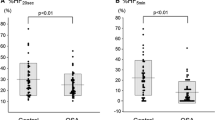Summary
Autonomous nervous functions do change with normal sleep and do show characteristic changes with sleep disorders. This is why the investigation of autonomous nervous function during sleep plays an important role. Two different and new methods will be introduced here. The pulse transit time (PTT) determines the time delay between ECG and the resulting peripheral pulse wave. PTT is reverse proportional to arterial blood pressure and changes in amplitude of the PTT signal do correlate well with intra-thoracic pressure changes. The peripheral arterial tonometry (PAT) determines the peripheral arterial vascular tone using a plethysmographic method. The peripheral arterial tone is modulated by sympathetic and parasympathetic activity, by peripheral blood pressure, and by the peripheral resistance of the vessels. Both signals are non-invasive methods to assess changes of autonomous nervous function. With the help of both signals in addition to cortical arousal it is possible to detect sub-cortical arousal. This effect and the high correlation with oesophageal pressure and blood pressure changes result in characteristic changes in PTT and PAT for obstructive sleep apnoea. The changes are so characteristic that they can be used diagnostically. In summary, PTT and PAT do show different aspects of the autonomous nervous function and cannot be substituted by each other. Both give important additional information to characterise arousal during sleep and sleep disorders. The clinical and cardiovascular consequences of sub-cortical arousal need prospective long-term follow-up studies.
Zusammenfassung
Die vegetativen Funktionen ändern sich mit dem physiologischen Schlaf und zeigen weitere charakteristische Änderungen bei Schlafstörungen. Damit hat die Untersuchung der vegetativen Funktionen im Schlaf eine wichtige diagnostische Bedeutung. Zwei verschiedene neue Methoden werden hier vorgestellt. Die Pulstransitzeit (PTT) bestimmt die Verzögerungszeit zwischen EKG und peripherer Pulswelle. Die PTT ist zum arteriellen Blutdruck umgekehrt proportional und die Amplitudenänderungen stehen in engem Zusammenhang mit den intrathorakalen Druckschwankungen. Die periphere arterielle Tonometrie (PAT) bestimmt plethysmographisch den peripheren Gefäßtonus. Der periphere Gefäßtonus ist beeinflusst von sympathischer und parasympathischer Aktivität, vom peripheren Blutdruck, und dem Widerstand der Gefäße. Beide Signale sind nicht-invasive Methoden um Veränderungen der autonomen Funktion zu erfassen. Mit beiden Signalen können zusätzlich zu kortikalen Arousal auch subkortikale Arousal erkannt werden. Dadurch und durch die Korrelation mit Ösophagusdruck und Blutdruck zeigen sich für PTT und PAT charakteristische Veränderungen bei Schlafapnoe, die diagnostisch auswertbar sind. PTT und PAT spiegeln unterschiedliche Aspekte der vegetativen Funktion im Schlaf auf und sind daher nicht austauschbar. Sie stellen wichtige zusätzliche Informationen zur Beurteilung des Schlafes und der Schlafstörungen durch Arousal dar. Die klinische und kardiovaskuläre Bedeutung subkortikaler Arousal erfordert prospektive Langzeituntersuchungen.
Similar content being viewed by others
References
Akselrod S, Gordon D, Ubel FA, Shannon DC, Barger AC, Cohen RJ: Power spectrum analysis of heart rate fluctuations: a quantitative probe of beat-to-beat cardiovascular control. Science 213: 220–222, 1981.
American Academy of Sleep Medicine Task Force: Sleep-related breathing disorder in adults: Recommendations for syndrome definition and measurement techniques in clinical research. Sleep 22: 667–689, 1999.
Argod J, Pépin J-L, Lévy P. Differentiating obstructive and central sleep respiratory events through pulse transit time. Am J Respir Crit Care Med 158: 1778–1783, 1998.
Argod J, Pépin J-L, Smith RP, Lévy P. Comparison of esophageal pressure with pulse transit time as a measure of respiratory effort for scoring obstructive nonapneic respiratory events. Am J Respir Crit Care Medicine 162: 87–93, 2000.
Barschdorff D, Ehrig M, Kontinuierliche Blutdruck be stimmung während des Belastungs-EKG. Biomed. Technik 43: 34–39, 1998.
Duchna HW, Guilleminault C, Stoohs RA, Faul JL, Moreno H, Hoffman BB, Blaschke TF: Vascular Reactivity in Obstructive Sleep Apnea Syndrome. Am J. Respir. Crit. Care Med 161: 187–191, 2000.
Grote L, Schneider H, Podszus T: Kreislauf und Schlaf. Somnologie 1: 27–36, 1997.
Lavie P, Schnall RP, Sheffy J, Shlitner A: Peripheral vasoconstriction during REM sleep detected by a new plethysmographic method. Nature Medicine 6: 606, 2000.
Penzel T, Brandenburg U, Fischer J, Jobert M, Kurella B, Mayer G, Niewerth HJ, Peter JH, Pollmächer T, Schäfer T, Steinberg R, Trowitzsch E, Warmuth R, Weeß H-G, Wölk C, Zulley J: Empfehlungen zur computergestützten Aufzeichnung und Auswertung von Polygraphien. Somnologie 2: 42–48, 1998.
Penzel T, Fricke R, Becker HF, Conradt R, Jerrentrup A, Peter JH: Comparison of Peripheral Arterial Tonometry and Invasive Blood Pressure in Obstructive Sleep Apnea. Sleep 24 (Suppl.) A264, 2001.
Pitson D, Chhina N, Knijn S, van Herwaaden M, Stradling J: Changes in pulse transit time and pulse rate as markers of arousal from sleep in normal subjects. Clin Sci (London) 87: 269–273, 1994.
Pitson DJ, Stradling JR: Autonomic markers of arousal during sleep in patients undergoing investigation for obstructive sleep apnoea, their relationship to EEG arousals, respiratory events and subjective sleepines. J Sleep Research 7: 53–59, 1998.
Schnall RP, Shlitner A, Sheffy J, Kedar R, Lavie P, Periodic, Profound Peripheral Vasoconstriction—a new Marker of Obstructive Sleep Apnea. Sleep 22: 939–946, 1999.
Stradling JR, Davies RJO, Pitson DJ: New Approaches to Monitoring Sleep-Related Breathing Disorders. Sleep 19: S77-S84, 1996.
Verrier RL, Muller JE, Hobson JA: Sleep, dreams, and sudden death: the case for sleep as an autonomic stress test for the heart. Cardiovasc Res 31: 181–211, 1996.
Verrier RL, Harper RM, Hobson JA: Cardiovascular Physiology: Central and Autonomic Regulation. In: Kryger MH, Roth T, Dement WC (eds). Principles and Practice of Sleep Medicine. Philadelphia: WB Saunders 179–191, 2000.
Author information
Authors and Affiliations
Corresponding author
Rights and permissions
About this article
Cite this article
Penzel, T., Brandenburg, U., Fricke, R. et al. New methods for the non-invasive assessment of sympathetic activity during sleep. Somnologie 6, 69–73 (2002). https://doi.org/10.1046/j.1439-054X.2002.02178.x
Issue Date:
DOI: https://doi.org/10.1046/j.1439-054X.2002.02178.x
Keywords
- autonomous nervous function
- peripheral arterial tonometry
- pulse transit time
- arousal
- sub-cortical arousal
- sympathetic tone
- sleep apnoea




